Related Research Articles

A hula hoop is a toy hoop that is twirled around the waist, limbs or neck. The modern hula hoop was invented in 1958 by Arthur K. "Spud" Melin and Richard Knerr, but children and adults around the world have played with hoops throughout history. Hula hoops for children generally measure approximately 70 centimetres (28 in) in diameter, while those for adults measure around 1 metre (40 in). Traditional materials for hoops include willow, rattan, grapevines and stiff grasses. Today, they are usually made of plastic tubing.

ʻIolani School, located at 563 Kamoku Street in Honolulu, Hawaiʻi, is a private coeducational college preparatory school serving over 2,020 students with a boarding program for grades 9 - 12 as well as a summer boarding program for middle school grades. Founded in 1863 by Father William R. Scott, it was the principal school of the former Anglican Church of Hawaiʻi. It was patronized by Kamehameha IV and Queen Emma who gave the school its name in 1870. ʻIolani in the Hawaiian language means "heavenly hawk". Today, ʻIolani School is affiliated with the Episcopal Church in the United States. It is administered by a Board of Governors and is one of the largest independent schools in the United States.
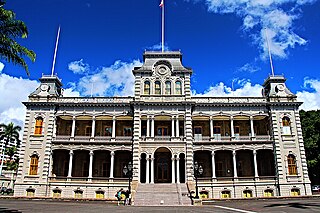
The ʻIolani Palace was the royal residence of the rulers of the Kingdom of Hawaii beginning with Kamehameha III under the Kamehameha Dynasty (1845) and ending with Queen Liliʻuokalani (1893) under the Kalākaua Dynasty, founded by her brother, King David Kalākaua. It is located in the capitol district of downtown Honolulu in the U.S. state of Hawaiʻi. It is now a National Historic Landmark listed on the National Register of Historic Places. After the monarchy was overthrown in 1893, the building was used as the capitol building for the Provisional Government, Republic, Territory, and State of Hawaiʻi until 1969. The palace was restored and opened to the public as a museum in 1978. The ʻIolani Palace is the only royal palace on US soil.
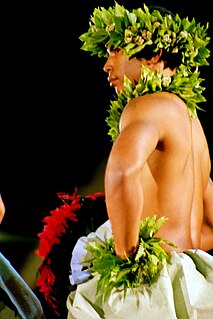
The Merrie Monarch Festival is a week-long cultural festival that takes place annually in Hilo, Hawaii during the week after Easter. It honors King David Kalākaua, who was called the "Merrie Monarch" for his patronage of the arts and is credited with restoring many Hawaiian cultural traditions during his reign, including the hula. Many hālau hula (schools), including some from the U.S. mainland and some international performers, attend the festival each year to participate in exhibitions and competitions. The festival has received worldwide attention and is considered the most prestigious of all hula contests.

Mauna ʻAla in the Hawaiian language, is the Royal Mausoleum of Hawaii and the final resting place of Hawaii's two prominent royal families: the Kamehameha Dynasty and the Kalākaua Dynasty.

The Hula Bowl is a post-season college football all-star game held annually in Hawaii, usually in January. The game was first played from 1947 to 2008, and is being revived following the 2019 season. The first playing since 2008 is scheduled for January 26, 2020, at Aloha Stadium in the Halawa district of Honolulu. During its history, the game has also been played at Honolulu Stadium, and at War Memorial Stadium on the island of Maui.

King Kamehameha I Day on June 11 is a public holiday in the U.S. state of Hawaii. It honors Kamehameha the Great, the monarch who first established the unified Kingdom of Hawaiʻi—comprising the Hawaiian Islands of Niʻihau, Kauaʻi, Oʻahu, Molokaʻi, Lānaʻi, Kahoʻolawe, Maui, and Hawaiʻi. In 1883 a statue of King Kamehameha was dedicated in Honolulu by King David Kalākaua. There are duplicates of this statue in Emancipation Hall at the Capitol Visitor Center in Washington, D.C. and in Hilo, island of Hawaiʻi.
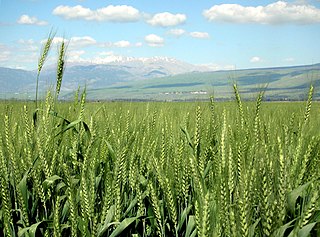
The Hula Valley is an agricultural region in northern Israel with abundant fresh water, which used to be Lake Hula, prior to its draining. It is a major stopover for birds migrating along the Syrian-African Rift Valley between Africa, Europe, and Asia. Lake Hula and the marshland surrounding it were a breeding ground for mosquitoes carrying malaria, and so were drained in the 1950s. A small section of the valley was later re-flooded in an attempt to revive a nearly extinct ecosystem. An estimated 500 million migrating birds now pass through the Hula Valley every year.

Hula was an open source mail and calendar project based on open standards announced on February 15, 2005 by Novell.

The Hawaiian Renaissance was the Hawaiian resurgence of a distinct cultural identity that draws upon traditional kānaka maoli culture, with a significant divergence from the tourism-based culture which Hawaiʻi was previously known for worldwide.
The World Invitational Hula Festival is a three-day event that perpetuates Hawaiian culture as a celebration of the artistic rendering of the Hawaiian hula dance. The festival is in its 20th year of production and is the largest and farthest reaching event of its kind.
Albert Lolotai was an American football offensive lineman in the National Football League for the Washington Redskins. He also played for the Los Angeles Dons in the All-America Football Conference. He played college football at Weber Junior College. Lolotai was the first Samoan American and Polynesian to play professional American football.
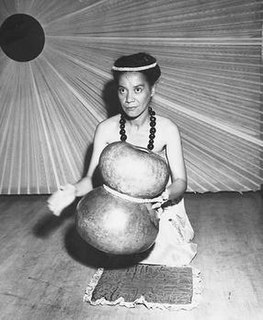
ʻIolani Luahine, born Harriet Lanihau Makekau, was a native Hawaiian kumu hula, dancer, chanter and teacher, who was considered the high priestess of the ancient hula. The New York Times wrote that she was "regarded as Hawaii's last great exponent of the sacred hula ceremony," and the Honolulu Advertiser wrote: "In her ancient dances, she was the poet of the Hawaiian people." The ʻIolani Luahine Hula Festival was established in her memory, and awards a scholarship award each year to encourage a student to continue the study of hula.
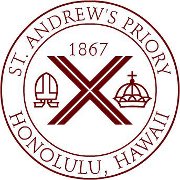
St. Andrew's Priory School is a private all-girls college preparatory school in Honolulu, Hawaii. Founded in 1867 by Queen Emma Kaleleonālani, wife of King Kamehameha IV, the school enrolls students in kindergarten through grade 12. The enrollment is 550, with a student-teacher ratio of 8 to 1. Today, the school is affiliated with the Episcopal Church. It is administered by a Board of Trustees and is the oldest all-girls school in Hawai'i. More than half the faculty have advanced degrees and virtually 100% of graduates attend four-year colleges and universities across the country.

John Kameaaloha Almeida was a blind musician and songwriter from Oahu, Hawaii. His 1930s radio program on Hawaii radio station KGU earned him the sobriquet "The Dean of Hawaiian Music". By the time of his death he had composed hundreds of meles that have today become Hawaiian music standards.
Bill Ali'iloa Lincoln was a Hawaiian hula singer and musician, noted for his soaring falsetto.

William Austin Whiting was an American lawyer and politician of the Kingdom, Republic, and Territory of Hawaii. He served as Attorney General of Hawaii and was an associate justice of the Supreme Court of Hawaii. During his college years, he was captain of the 1875 Harvard Crimson football team.

Kini Kapahu Wilson was a Hawaiian hula dancer, musician, and singer. In 1893–94, she toured the United States, Europe and Russia, performing for heads of state such as Kaiser Wilhelm II and Tsar Nicholas II. She married Honolulu Mayor John H. Wilson and was recognized as the "Honorary First Lady" of Hawaii.

George Panila Kamauoha was a Native Hawaiian politician of Hawaii. He served in the legislature of the Kingdom of Hawaii and the Republic of Hawaii and later in the Senate of the Territory of Hawaii.
References
https://web.archive.org/web/20090503151709/http://www.limahula.com/iolani.htm
| This dance-related article is a stub. You can help Wikipedia by expanding it. |
| This festival-related article is a stub. You can help Wikipedia by expanding it. |